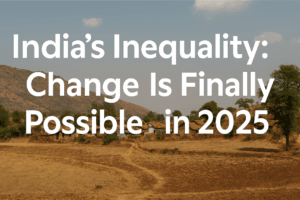India’s Inequality: 7 Powerful Reasons Why Change Is Finally Possible in 2025
India continues to face deep-rooted and uneven poverty, especially in its rural regions, where over 300 million people still lack access to basic needs like housing, education, and employment. Despite decades of development programs, deprivation remains widespread and varies sharply across states. A Composite Deprivation Index (CDI) reveals that states like Odisha, Bihar, and Jharkhand face the highest levels of deprivation, while Kerala, Goa, and Himachal Pradesh rank among the least deprived.
These disparities are tied to historical neglect, poor infrastructure, and underinvestment in central and northeastern regions. Addressing this issue requires more than generic policies; it calls for region-specific solutions tailored to local needs. Key strategies include boosting infrastructure, expanding education and skill training, improving welfare schemes, and empowering local governance. The focus must shift from uniform national programs to targeted interventions that account for the unique challenges of each region.
Solving India’s inequality crisis demands strong political commitment, efficient administration, and meaningful community participation.

India’s Inequality: 7 Powerful Reasons Why Change Is Finally Possible in 2025
India’s battle against poverty highlights a harsh reality: millions still struggle with extreme deprivation, particularly in rural regions. Despite progress, over 300 million people lack access to essentials like clean water, education, stable jobs, and proper housing. Tackling these challenges requires more than economic growth alone—it demands political will, efficient governance, and communities working together to drive change.
Poverty Beyond Income: A Multidimensional Crisis
Poverty in India isn’t just about low income. It’s a complex web of challenges: crumbling homes, unsafe drinking water, inadequate toilets, limited schooling, and weak social support. These issues vary widely across states, shaped by historical neglect, outdated policies, and unequal development. To map these disparities, experts use the Composite Deprivation Index (CDI), which measures four key areas:
- Housing quality (e.g., durable roofs, ventilation)
- Basic amenities (electricity, water, sanitation)
- Social factors (education, healthcare, digital access)
- Economic security (income stability, employment)
By analyzing government data, the CDI reveals stark regional divides in living conditions.
Where Deprivation Runs Deep
States with “very high deprivation”—like Odisha, Bihar, Chhattisgarh, Jharkhand, and Assam—face severe shortages. Families here often live in makeshift homes, lack toilets, and earn less than ₹5,000 monthly. Children struggle to access schools, while adults depend on unstable daily wage jobs. States such as West Bengal, Rajasthan, and Meghalaya also fall into this category, with healthcare and infrastructure lagging far behind.
In the “high deprivation” group—Uttar Pradesh, Maharashtra, and Tamil Nadu—progress is mixed. While cities like Mumbai or Chennai show economic vibrancy, rural areas grapple with poor housing, water scarcity, and limited job opportunities. Northeastern states like Mizoram and Nagaland, though culturally rich, face similar gaps in development.
States with “moderate deprivation”, such as Gujarat and Karnataka, showcase uneven growth. Urban centers thrive with industries and literacy programs, but villages lack basic facilities. Meanwhile, Uttarakhand and Sikkim struggle to balance tourism-driven economies with rural poverty.
The least deprived states—Kerala, Goa, and Himachal Pradesh—boast better infrastructure, education, and healthcare. Kerala’s near-universal literacy and Himachal’s rural connectivity set examples. Yet, even these regions have pockets of inequality, such as marginalized communities in Punjab or conflict-affected areas in Jammu & Kashmir.
The Roots of Regional Divides
India’s development story is deeply unequal. Central and northeastern states, historically overlooked, suffer from underinvestment in roads, schools, and hospitals. Colonial-era policies prioritized certain regions, while post-independence plans failed to bridge these gaps. For instance, tribal areas in Chhattisgarh or Odisha remain isolated, lacking access to markets or modern farming techniques.
Building Tailored Solutions
A one-size-fits-all approach won’t work. Each region needs strategies aligned with its unique challenges:
- Boost Investment in Neglected Regions
Underdeveloped states require targeted funding for infrastructure—roads, electricity, hospitals—and job creation. Public-private partnerships can spur industries suited to local resources, like agro-processing in Bihar or tourism in Meghalaya. - Education and Skills for Empowerment
Literacy campaigns and vocational training can break cycles of poverty. Digital initiatives, like Rajasthan’s online classrooms, help rural students access quality education. Skill programs in construction, healthcare, or handicrafts can equip youth for better-paying jobs. - Strengthen Welfare Programs
Direct cash transfers, subsidized rations, and expanded healthcare coverage provide immediate relief. Programs like MGNREGA (rural employment guarantee) must be streamlined to ensure fair wages and timely payments. - Empower Local Communities
Village councils and tribal leaders understand local needs best. Decentralizing decision-making can lead to better-targeted projects, such as building check dams in drought-prone Maharashtra or promoting organic farming in Sikkim. - Create Sustainable Livelihoods
Small farmers need access to credit, irrigation, and markets. Promoting cottage industries, like weaving in Assam or pottery in Uttar Pradesh, can boost rural incomes. Renewable energy projects, such as solar farms in Rajasthan, offer dual benefits: jobs and clean power.
The Path Forward
India’s fight against inequality hinges on acknowledging its regional complexities. While Kerala’s social reforms or Himachal’s education models offer lessons, replicating them requires adapting to local contexts. Policymakers must prioritize inclusivity—ensuring tribal communities, women, and marginalized castes aren’t left behind.
Economic growth alone won’t suffice. Closing the deprivation gap demands the courage to overhaul outdated systems, invest in human capital, and trust communities to lead their own progress. Only then can India achieve a future where prosperity isn’t confined to a few states but shared by all.
You must be logged in to post a comment.